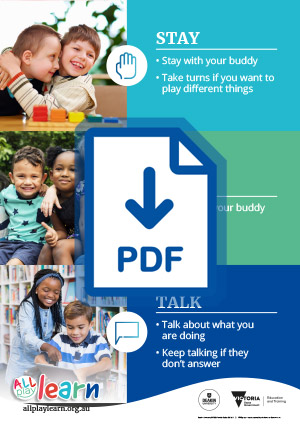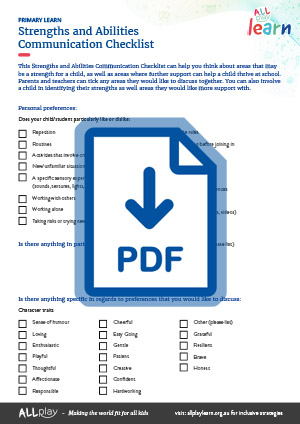
Blind and Low Vision
On this page:

About blind and low vision
‘Blind and low vision’ refers to significant and ongoing challenges with the ability to see. Some children may be considered ‘legally blind’ if they cannot see beyond six metres (compared to 60 metres for a child with normal vision) or if their visual field is less than 20 degrees in diameter (compared to 140 degrees for a child with normal vision). Some children may be considered to have ‘low vision’ if they have permanent vision loss that cannot be corrected with glasses and their ability to complete everyday tasks is affected. Children with low vision may have some sight, but experience difficulties with visual acuity (being able to see detail), accommodation (being able to focus), field of vision (the area that can be seen), colour vision and adapting to different lighting between environments.
As an educator knowing about the type and severity of vision impairment a child has will help you know how best to support them. Some children might be learning to read Braille, or use low vision aid technology like electronic magnifiers, closed-circuit television or tablets. They might need large print materials. Understanding each child’s strengths and abilities will allow you to develop ideas about ways to make education safe, fun, and as inclusive as possible.

Strengths
What might be some strengths?
- Children who are blind or low vision can often pay attention normally.
- Some children with low vision respond well to colourful and moving objects.
- Some children who are blind or low vision may have heightened hearing and sense of touch.
- They will often be able to learn just as well as others, if given the right types of learning materials.
Where you can provide support?
- Some children may have trouble making eye contact, reading facial expressions and observing social cues. This can make it more difficult for them to develop and show empathy, and to connect and play with other children.
- Some children may find learning how to talk to others challenging.
- They may find it hard to join in an activity with other children.
- They may find it hard to change activities, or they may become upset if plans are changed without warning.
- Exploring the environment, moving around, and reaching for objects may be challenging.
- Some children may not have as many opportunities to develop play skills.

Evidence-based strategies

Best practice tips
Target literacy skills
Consider safety
Encourage clear communication
Help a child develop their social skills
Promote self-determination
- Promote self-determination. Empower and teach children to make simple choices, set goals, be independent, and develop problem-solving abilities. Use technology as needed.

Early Years Learning and Development Outcomes
Outcome 1: Children have a strong sense of identity
Outcome 2: Children are connected with and contribute to their world
Outcome 3: Children have a strong sense of wellbeing
Outcome 4: Children are confident and involved learners
Outcome 5: Children are effective communicators

Other considerations
Safety
Excursions/incursions
Emergency drills
Behaviour
Building relationships
New environments
Transitions
Braille
Low vision aids
Other common challenges

Relevant resources
Visit our Resources page for a range of resources that can help to create inclusive education environments for children with disabilities and developmental challenges. Some particularly relevant resources for children who are blind and low vision include our Audio Stories, and:


